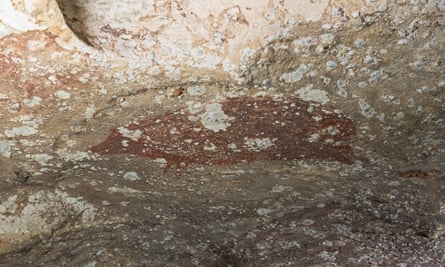Oldest known image fable is a 51,000-year-long-established Indonesian cave painting – Guardian

The field’s oldest known image fable is a cave painting practically 6,000 years older than the earlier yarn holder, found about 10km away on the identical island in Indonesia, a world crew of archaeologists has acknowledged.
The painting, believed to be no longer no longer up to 51,200 years long-established, was as soon as found at Leang Karampuang cave on the east Indonesian island of Sulawesi, researchers from Griffith College, Southern Hideous College and the Indonesian National Compare and Innovation Company wrote within the journal Nature.
Samples were light in 2017, however weren’t dated till earlier this year.
The earlier yarn holder was as soon as a lifesize image of a wild pig believed to be created no longer no longer up to 45,500 years within the past in a cave at Leang Tedongnge.
The goal no longer too prolonged within the past found painting is of three therianthropes – or human-animal hybrids – and a wild pig.

Adhi Agus Oktaviana, the lead writer and a PhD pupil at Griffith College, acknowledged the findings were “very aesthetic”.
He acknowledged the art was as soon as well-known older than eminent European ice-age art, such as paintings within the Lascaux caves in France, which would per chance per chance be believed to be about 20,000 years long-established.
The discovering contradicts the educational behold that early figurative cave art consisted of single figure panels in location of scenes the place figures interacted with every other.
The researchers long-established uranium series relationship to this level the layers of calcium carbonate that had formed on top of the art. It alive to extracting limestone samples that were then vaporised with a laser. The age of the sample was as soon as calculated by measuring the ratio of thorium to uranium.
The researchers acknowledged this formula allowed the layers to be dated extra accurately by guaranteeing younger and older materials weren’t blended collectively.
The researchers also dated art at a nearby cave – Leang Bulu’ Sipong 4 – that was as soon as previously believed to be the oldest cave art within the arena. They chanced on that the paintings, as soon as believed to be no longer no longer up to 44,000 years long-established, was as soon as no longer no longer up to Forty eight,000 years long-established.
Nonetheless, the space of the dilapidated oldest known cave painting at Leang Tedongnge is no longer going to be dated the utilization of the more recent formula, as there was as soon as no calcium carbonate enviornment topic final.
Dr Tristen Jones, a rock art professional on the College of Sydney, acknowledged the unique formula was as soon as “a predominant soar forward in tightening up the resolution and accuracy of relationship”. Generally, she acknowledged, rock art is amazingly sophisticated to this level as the art is predominately made of minerals. It capacity that radiocarbon relationship, which is continuously long-established to this level coral reefs, doesn’t work.
Adam Brumm, a professor from Griffith College who collectively led the stare, acknowledged that within the plenty of excavations he had performed within the blueprint, there were frequent depictions of the warty pig. “They were clearly economically crucial to those elite of us,” he acknowledged. “We can glimpse they were also crucial to them symbolically and even in all likelihood spiritually”.
Nonetheless, the researchers acknowledged the events taking location within the paintings were “sophisticated to account for”, and it was as soon as unclear what animals impressed the human-animal hybrids as they were drawn as “genuinely stick figures”.
“For whatever motive … early individuals … [are] no longer continuously ever depicted any invent that would possibly per chance be moderately interpreted as a human,” Brumm acknowledged. “Animals were continuously drawn with unbelievable anatomical fidelity, however [early cave painters] place less effort into doing that.”
He acknowledged the researchers were slightly distinct one in all the human-animal hybrids was as soon as a human with the pinnacle of a rooster, and yet one more had a tail, believed to be that of a civet.
“Storytelling is a hugely crucial phase of human evolution and per chance even helps to articulate our success as a species, however discovering proof for it in art, especially in very early cave art, is exceptionally rare.”


